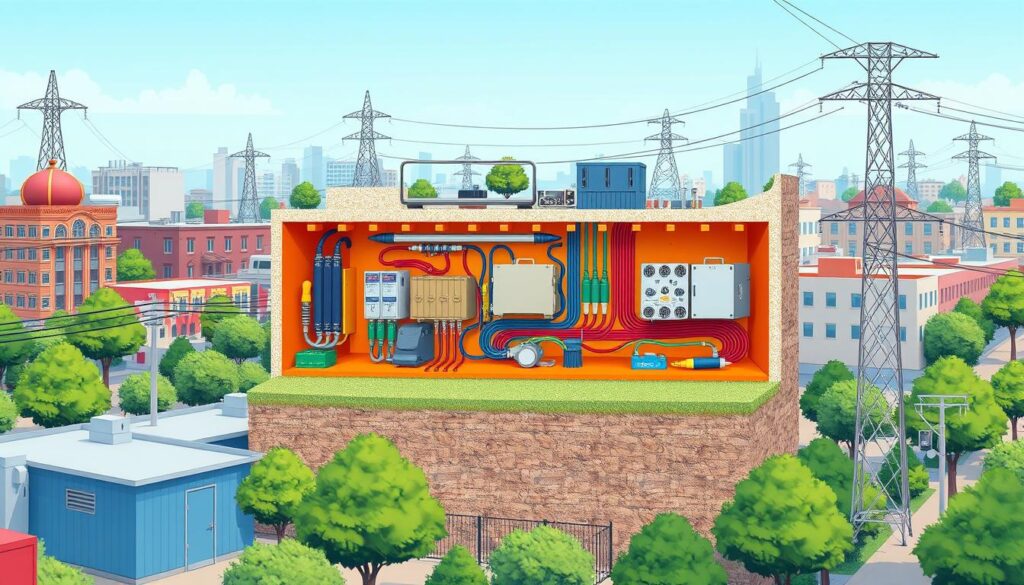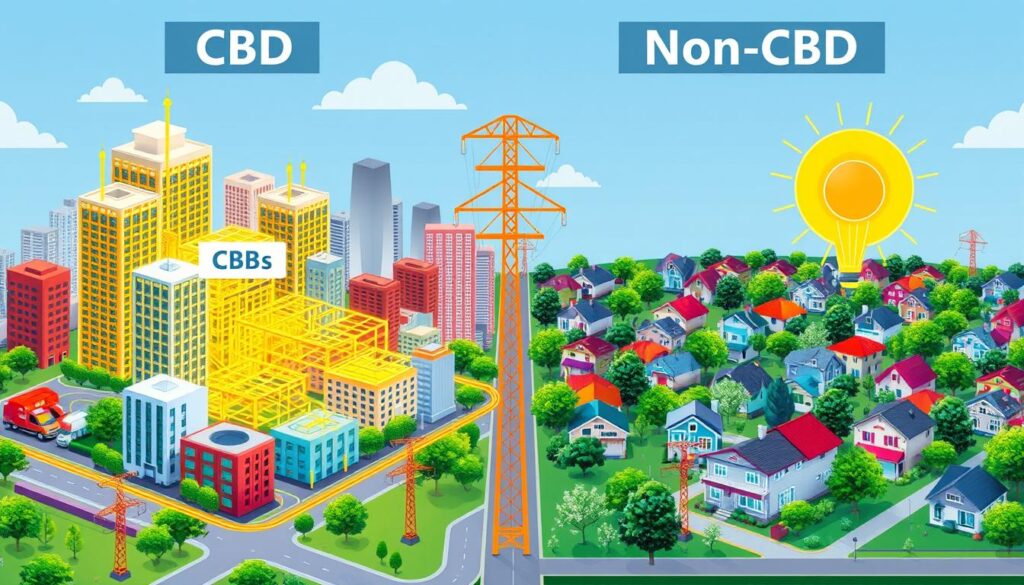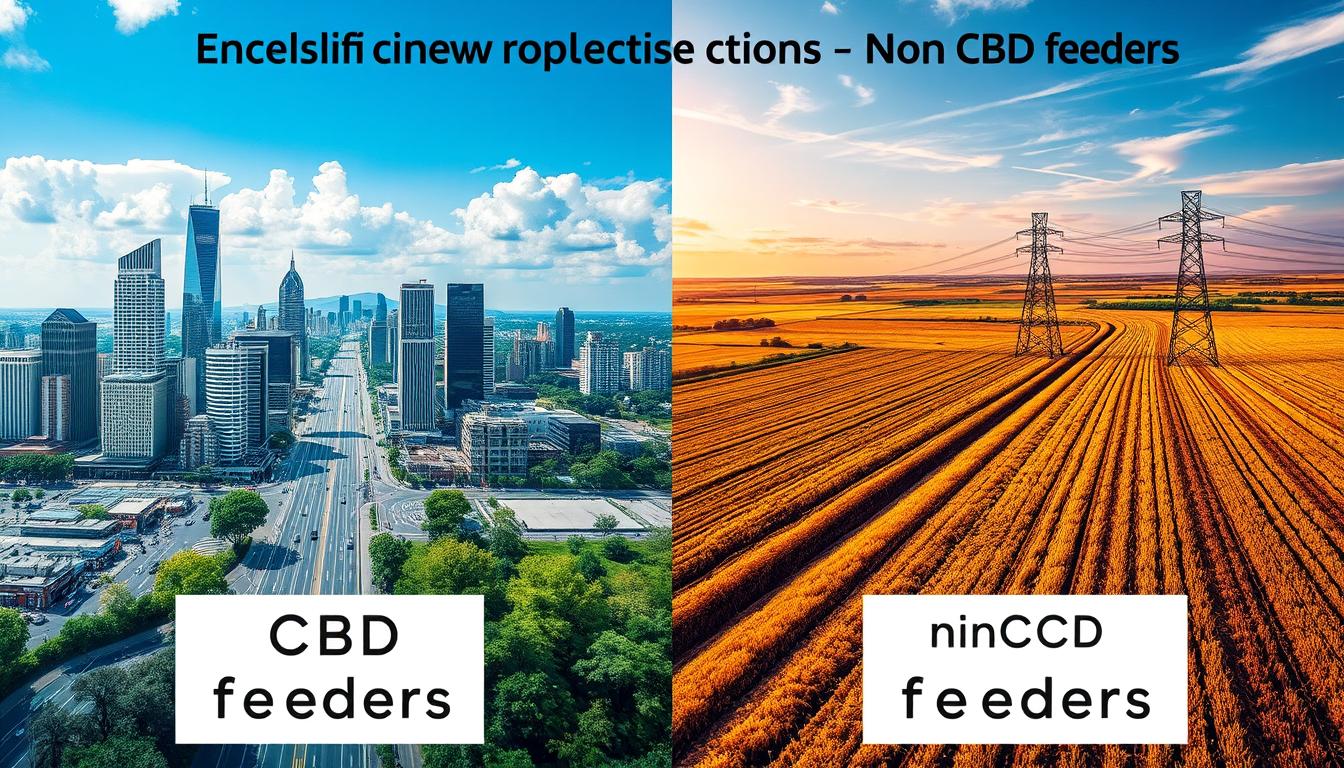As I explore energy distribution, a key question emerges: are endeavour energy feeders non-cbd or cbd ipart? This question is crucial for managing and delivering electricity. It affects how power moves from substations to homes and businesses, especially in cities and towns.
Knowing if these feeders are CBD or non-CBD is important. It impacts how we manage our infrastructure and set prices for electricity. This affects everyone involved in the energy sector.
CBD feeders serve the busy city centers, where demand is high due to work and industry. On the other hand, non-CBD feeders go to homes, towns, and rural areas. The demand here is different.
Understanding this classification is key. It helps plan how to deliver energy efficiently. This benefits both the energy companies and the people using the power.
Key Takeaways
- CBD feeders face higher demand due to commercial activity.
- Non-CBD feeders serve a mix of residential and rural areas.
- Infrastructure needs differ between CBD and non-CBD feeders.
- Pricing models are influenced by feeder classification.
- Correct classification supports fair electricity pricing.
- ipart guidelines help delineate feeder categories.>
ipart>
What Are Endeavour Energy Feeders?
Endeavour Energy feeders are key in the electricity network. They move power from big networks to local spots. This is important for both cities and rural areas, making sure everyone gets power.
Understanding these feeders means looking at how power is spread out. We also need to know what makes them work well.
Overview of Energy Distribution
The power system uses many feeders to meet area needs. Endeavour Energy feeders are crucial for both city centers and other places. City feeders handle high demand from businesses and offices. Non-city feeders serve homes, towns, and countryside, based on local needs.
Key Features of Energy Feeders
Energy feeders have important features that show their value:
- Conduit for Electricity: They carry power to users.
- Operational Capacities: Each feeder can handle certain loads, fitting local needs.
- Regulatory Standards: They must meet strict rules for efficiency, safety, and reliability.
- Cost Variability: Costs vary between city and non-city feeders, affecting what people pay for power.
- Resource Allocation: Proper feeder types help manage resources, affecting maintenance and upgrades.
| Feeder Type | Area Served | Operational Costs | Impact on Pricing |
|---|---|---|---|
| CBD Feeders | Densely Populated | Higher | Potentially Higher Tariffs |
| Non-CBD Feeders | Residential/Regional/Rural | Lower | More Affordable Rates |
Understanding CBD and Non-CBD Classifications
It’s important to know the difference between CBD and non-CBD energy feeders. This helps us understand how they work and their effects on prices. Knowing this can also help us see how energy investments are made and what it means for us.
Definition of CBD in Energy Context
CBD feeders serve busy cities with lots of businesses and homes. These places need strong energy systems to meet their needs. This means higher costs for keeping everything running smoothly, which can lead to higher bills for us.
Understanding CBD energy helps us see the challenges of powering these lively cities. It shows how complex energy distribution can be.
Definition of Non-CBD in Energy Context
Non-CBD feeders, however, are for quieter areas like suburbs and rural spots. These places have less energy demand, so costs are lower. This can mean cheaper electricity for us.
Planning for non-CBD feeders focuses on getting energy to everyone. It’s about fairness in access to power. These differences are key in managing energy across different areas, affecting prices and how resources are used.
| Feeder Type | Characteristics | Operational Costs | Impact on Consumers |
|---|---|---|---|
| CBD | Densely populated, high commercial activity | Higher | Potentially increased tariffs |
| Non-CBD | Residential suburbs, rural areas | Lower | More affordable electricity rates |
What Does CBD and Non-CBD Mean in IPART Context?
Understanding CBD and non-CBD is key in the IPART world. It affects how we price energy. These terms mean different things for energy costs and how they reach us.
Classification Based on Geographic Considerations
In the IPART world, where you are matters. CBD areas, like cities, cost more to serve because of more people and infrastructure needs. The Electricity Distribution Code sets standards for these areas.
Non-CBD areas, like the countryside, cost less to serve. This means electricity is cheaper for people there. The difference in cost is because of where you live.
Impact on Pricing Models
How we price energy changes based on CBD and non-CBD areas. CBD areas have higher prices because of their costs. These prices also depend on customer feedback.
Non-CBD areas have lower prices because they cost less to serve. As new tech and business models come, prices might change. This keeps prices fair and reflects the real cost of service.
| Aspect | CBD Feeders | Non-CBD Feeders |
|---|---|---|
| Location | Urban Areas | Rural Areas |
| Operational Costs | Higher | Lower |
| Electricity Pricing | Higher Tariffs | Affordable Rates |
| Customer Demand | Concentrated | Variable |
| Regulatory Standards | Tighter Regulations | Flexible Regulations |
Characteristics of CBD Feeders
CBD feeders are key in distributing energy. They serve areas with lots of people and businesses. This makes their role in managing electricity very important.
Service Areas and Demand
CBD feeders cover busy city centers and high-density areas. These places need a lot of power for businesses and tall buildings. This high demand makes these feeders essential for reliable power.
Infrastructure Requirements
The setup for CBD feeders is more complex than others. They need to handle high energy peaks. This means using the latest tech and strong facilities.
If they can’t keep up, it can cause problems. This includes power outages and higher costs. So, their setup must keep up with city energy needs.
| Infrastructure Characteristic | CBD Feeders | Non-CBD Feeders |
|---|---|---|
| Peak Load Capacity | High | Lower |
| Technology Implementation | Advanced systems for efficiency | Standard systems |
| Operational Costs | Higher due to demand | Lower, more affordable |
| Typical Tariff Structure | Higher tariffs | More competitive rates |

Characteristics of Non-CBD Feeders
Non-CBD feeders play a key role in the energy network. They help meet electricity needs in different areas. This is crucial for various types of locations.
Types of Areas Served
Non-CBD feeders usually power:
- Residential suburbs
- Regional towns
- Rural zones
These areas face unique challenges and opportunities. The number of people living there can change. This affects how reliable and needed the electricity is.
Demand Variability
The demand for electricity in non-CBD feeders changes for several reasons:
- Population distribution: Less people in some areas means less and more uneven demand.
- Seasonal activities: Demand goes up during holidays or when farming is in season.
- Industrial presence: Fewer industries make it harder to predict energy needs.
These factors make non-CBD feeders different from city centers. Handling these differences is key to better infrastructure and energy service.
Are Endeavour Energy Feeders Considered Non-CBD or CBD IPART?
The type of feeder under IPART rules depends on location, demand, and service type. Feeders in cities are usually CBD. These support areas with lots of people, leading to higher costs for energy.
On the other hand, non-CBD feeders serve suburbs and rural areas. They have lower demand and costs. This makes their electricity prices more affordable.
This difference affects how much people pay for electricity. CBD feeders charge more because of their complex needs. Non-CBD feeders charge less, thanks to simpler systems.
Knowing this helps plan better for energy needs. It guides how to invest in different areas. It also ensures energy is delivered efficiently, keeping customers happy.
Classification Criteria Under IPART Guidelines
It’s key to know the IPART guidelines classification for energy feeders. This process looks at where the feeders are and who they serve. It helps manage the energy system and set prices right.
Location and Service Area
The spot where energy feeders are matters a lot. In cities, they face a lot of demand from businesses and factories. They need strong systems to handle this.
But, in suburbs and rural areas, the demand is different. It changes based on how many people live there and what they do.
Consumer Demand Profiles
How much people use energy also shapes the classification. In cities, this means higher costs and possibly higher prices for electricity. But, in suburbs and rural areas, costs are lower, so prices are too.
As cities grow, how we classify energy feeders might change. This shows how energy needs and systems evolve together.
| Feeder Type | Location | Typical Demand | Operational Costs | Tariff Implications |
|---|---|---|---|---|
| CBD Feeders | Urban Areas | High | Higher | Potentially Higher Rates |
| Non-CBD Feeders | Residential/Rural Areas | Variable | Lower | More Affordable Rates |
This system helps follow rules and plan for energy needs. Keeping up with the IPART guidelines is important for good energy planning.
Why This Classification Matters
The importance of feeder classification is huge. Knowing if Endeavour Energy feeders are CBD or non-CBD changes a lot. It affects pricing and where we invest in the grid.
Impacts on Pricing Models
Feeder classification helps us see how prices change. CBD feeders cost more to run because they need special gear for busy city times. This means people might pay more for electricity.
On the other hand, non-CBD feeders cost less to run. This makes electricity cheaper for homes in suburbs and rural areas. The way we price electricity shows how important feeder classification is.
Influence on Infrastructure Investment
How we invest in the grid depends on feeder classification. CBD feeders need strong systems to keep up with city needs. Non-CBD feeders focus on reaching more people in less crowded places.
This smart planning makes sure we spend money where it does the most good. It helps make sure everyone gets reliable service.

| Feeder Type | Characteristics | Pricing Impacts | Infrastructure Needs |
|---|---|---|---|
| CBD Feeders | Serves densely populated areas, experiences high demand | Potentially higher tariffs due to operational costs | Requires advanced infrastructure to support peak loads |
| Non-CBD Feeders | Cater to residential suburbs and rural areas, varied demand | More affordable electricity rates due to lower operational costs | Focus on service expansion for underserved regions |
In short, understanding feeder classification helps us make better choices. It leads to smarter pricing and better use of resources. This improves service for everyone.
How to Determine the Classification of a Feeder?
Figuring out if an Endeavour Energy feeder is non-CBD or CBD takes some steps. You need to do thorough research. It’s key to use reliable sources, like official publications. These help by giving guidelines and showing important economic and geographic details.
Consulting IPART Documentation
First, check out IPART documents to get the criteria. IPART has detailed guides, maps, and rules for feeder types. These documents help by showing what’s expected and what’s important.
Analyzing Location and Demand
Next, look at the feeder’s location and demand. Knowing its area and how much people use it is crucial. IPART’s resources help figure out if the demand fits the feeder type. Keeping up with these documents helps me understand the classifications better.
Benefits of Proper Classification of Endeavour Energy Feeders
Understanding energy feeder classification shows many benefits. It affects how resources are used and managed. It helps ensure that the infrastructure can handle the needs of 2.4 million people in New South Wales.
This leads to better operation and customer happiness. So, the advantages of classifying energy feeders are huge.
Enhanced Resource Allocation
Western Sydney’s population is set to grow by 900,000 in 20 years. This means we need to plan better. Accurate feeder classification helps make smart investments.
It prepares for the 20,000 new customers each year. By knowing the difference between CBD and non-CBD feeders, Endeavour Energy can focus on the right upgrades. This saves money and improves service in growing areas.
Improved Pricing Transparency
Good classification makes prices clearer. People can see why energy costs vary by feeder type. Since 2012-13, network charges have gone down a lot.
This is thanks to better operations. Savings are passed on to customers. Knowing how tariffs relate to feeder types builds trust. It’s key for dealing with changing energy needs.
The Role of IPART in Energy Feeder Classification
The Independent Pricing and Regulatory Tribunal (IPART) plays a key role in classifying energy feeders. It makes sure the rules for energy feeders are fair and clear. This helps keep the energy market open and honest for everyone.
IPART’s framework helps manage energy distribution well. It benefits both those who use energy and those who provide it.
Regulatory Compliance and Oversight
IPART keeps the energy sector in line with rules. It sets standards for classifying energy feeders based on location and economic effects. These standards are important for correct feeder categorization.
The Guaranteed Service Level (GSL) guideline is a big part of these rules. It hasn’t changed since 2012. The rules for supply reliability have stayed the same since 2007, showing stability in expectations.
Supporting Fair Pricing Mechanisms
IPART focuses on fair prices for energy services. It plans to update the GSL Guideline and supply reliability boundaries in 2024. This is a response to the current market needs.
GSL payments are made when outages hit certain levels, depending on where customers are. This shows the importance of accurate feeder classification. IPART is open to feedback on these changes until April 2024.
This ongoing review shows IPART’s role in a strong energy system. It balances what’s good for consumers with what’s practical for providers.
Challenges in Classifying Energy Feeders
Classifying energy feeders is tricky due to geographic and economic overlaps. Urban areas are changing fast, making it hard to tell if a place is like a city center (CBD) or not. This requires deep analysis because demand can change a lot.
Geographic and Economic Overlaps
In cities, energy demand goes up because of businesses and factories. This makes costs for CBD feeders much higher than for others. On the other hand, non-CBD feeders serve homes in suburbs, towns, and rural areas. Their demand depends on local jobs and how many people live there. This shows that just looking at where a feeder is isn’t enough.
Fluctuating Demand Patterns
Demand for energy can change for many reasons, like the seasons or economic shifts. These changes make it hard to follow IPART rules for feeder classification. As cities grow, old systems might need to be updated, leading to changes in how feeders are classified. Getting it right helps with planning and setting prices, affecting what people pay for electricity.
Conclusion
Knowing the difference between CBD and non-CBD Endeavour Energy feeders is key. It affects how much we pay for electricity and how much is invested in the system. This knowledge helps everyone make better choices for a more efficient energy system.
Urban areas with lots of businesses have higher electricity needs. On the other hand, areas with homes and smaller businesses have different needs. This difference changes how much we pay and how resources are used.
The energy world is always changing. Keeping up with these changes is important. It helps us manage electricity better and meet everyone’s needs in a sustainable way.

Leave a Reply
You must be logged in to post a comment.